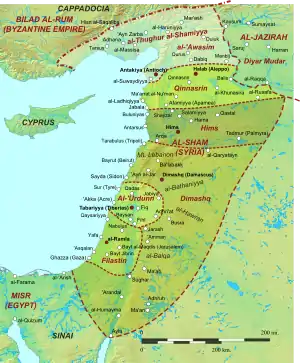Jund al-Urdunn
Jund al-Urdunn (Arabic: جُـنْـد الْأُرْدُنّ, translation: "The military district of Jordan") was one of the five districts of Bilad al-Sham (Islamic Syria) during the early Islamic period. It was established under the Rashidun and its capital was Tiberias throughout its rule by the Umayyad and Abbasid caliphates. It encompassed southern Mount Lebanon, the Galilee, the southern Hauran, the Golan Heights, and most of the eastern Jordan Valley (especially in the north).[1]

Subdistricts and major towns
The 10th-century geographer Ibn al-Faqih held that besides its capital at Tiberias, the Urdunn's chief districts (qura) were Samaria (al-Samira in Arabic), i.e. Nablus, Beisan, Qadas, Pella (Fahl in Arabic), Jerash, Acre (Akka in Arabic), and Tyre (Sur in Arabic).[2] The geographer al-Muqaddasi (d. 985) notes that the principal towns of the district were its capital Tiberias, Qadas, Tyre, Acre, Faradiyya, Kabul, Beisan, Lajjun and Adhri'at.[3] The 13th-century geographer Yaqut al-Hamawi counted the quras of Urdunn as Tiberias, Beisan, Acre, Beit Ras, Jadar (Jaydur, area adjacent to the east of the Golan Heights), Tyre and Saffuriya.[4]
The geographers Ibn Hawqal (d. c. 978) and Estakhri (d. 957) noted the Ghawr (Jordan Valley) district, the low-lying area along the Jordan River between Lake Tiberias to the Dead Sea, with its capital at Jericho (Ariha in Arabic), was administratively subordinate to Urdunn.[5] The geographer al-Ya'qubi (d. 892) held that the Ghawr was subordinate to Jund Dimashq.[2]
Governors
Rashidun period
- Yazid ibn Abi Sufyan (639, appointed by Caliph Umar after the death of the overall governor of Syria Abu Ubayda ibn al-Jarrah; concurrently governed the junds of Dimashq and Filastin)[6]
- Mu'awiya ibn Abi Sufyan (639-), may have been appointed to the post by Umar after the death of his brother Yazid in 639, when he was appointed to Dimashq)[6]
- Abu al-A'war al-Sulami, governor under Mu'awiya.[7]
Umayyad period
- Abu Uthman Aban ibn Marwan ibn al-Hakam (685–705, governed for unspecified period during his brother Caliph Abd al-Malik's rule;[7] identified by Moshe Gil as Aban ibn Marwan,[8] while Asad Q. Ahmed identified him with another brother of Abd al-Malik, Uthman ibn Marwan)[9]
- Ubayda ibn Abd al-Rahman al-Sulami (685–705, governed for unspecified period during Abd al-Malik's reign; nephew of Abu al-A'war)[7]
- Umar ibn al-Walid (705–715, governed during the rule of his father Caliph al-Walid I)[10]
- Ubada ibn Nusayy al-Kindi (717–720, governed during the rule of Caliph Umar II)[11]
- Ishaq ibn Qabisa ibn Dhu'ayb al-Khuza'i (724–743, governed during the rule of Caliph Hisham; son of one of Abd al-Malik's brother-in-laws and secretaries)[12]
- Al-Walid ibn Mu'awiya ibn Marwan (744–750, governed during the rule of his cousin Caliph Marwan II; a nephew of Abd al-Malik)[8]
Abbasid period
- Abdallah ibn Ali (752–753, governed during the rule of his nephew Caliph al-Saffah)[13]
- Ziyad ibn Abu al-Ward (amil, i.e. a fiscal supervisor, under Abdallah ibn Ali)[13])
- Muhammad ibn Ibrahim (754–775, governed during his the rule of his uncle Caliph al-Mansur; also governed Dimashq during al-Mansur's rule)[14]
See also
References
- Le Strange, G. (1890). Palestine Under the Moslems: A Description of Syria and the Holy Land from A.D. 650 to 1500. London: Committee of the Palestine Exploration Fund. pp. 30–39. OCLC 1004386.
- le Strange 1890, p. 30.
- le Strange 1890, p. 39.
- le Strange 1890, p. 32.
- le Strange 1890, pp. 30–31.
- Hinds 1993, p. 264.
- Crone 1980, p. 125.
- Gil 1997, p. 115.
- Ahmed 2010, p. 114.
- Crone 1980, p. 126.
- Crone 1980, p. 127.
- Crone 1980, p. 128.
- Sharon 1999, p. 218.
- Amitai-Preiss 2015, p. 72.
Bibliography
- Ahmed, Asad Q. (2010). The Religious Elite of the Early Islamic Ḥijāz: Five Prosopographical Case Studies. Oxford: University of Oxford Linacre College Unit for Prosopographical Research. ISBN 978-1-900934-13-8.
- Amitai-Preiss, Nitzan (2015). "What Happened in 155/771-72? The Testimony of Lead Seals". In Talmon-Heller, Daniella; Cytryn-Silverman, Katia (eds.). Material Evidence and Narrative Sources: Interdisciplinary Studies of the History of the Muslim Middle East. Leiden and Boston: Brill. ISBN 978-90-04-27159-3.
- Crone, Patricia (1980). Slaves on Horses: The Evolution of the Islamic Polity. Cambridge: Cambridge University Press. ISBN 0-521-52940-9.
- Gil, Moshe (1997) [1983]. A History of Palestine, 634–1099. Translated by Ethel Broido. Cambridge: Cambridge University Press. ISBN 0-521-59984-9.
- Hinds, M. (1993). "Muʿāwiya I b. Abī Sufyān". In Bosworth, C. E.; van Donzel, E.; Heinrichs, W. P. & Pellat, Ch. (eds.). The Encyclopaedia of Islam, New Edition, Volume VII: Mif–Naz. Leiden: E. J. Brill. pp. 263–268. ISBN 978-90-04-09419-2.
- Sharon, Moshe (1999). Corpus Inscriptionum Arabicarum Palaestinae (CIAP) Volume Two: B-C. Leiden, Boston and Koln: Brill. ISBN 90-04-11083-6.
- le Strange, Guy (1890). Palestine Under the Moslems: A Description of Syria and the Holy Land from A.D. 650 to 1500. London: Committee of the Palestine Exploration Fund. OCLC 1004386.CS1 maint: ref=harv (link)
